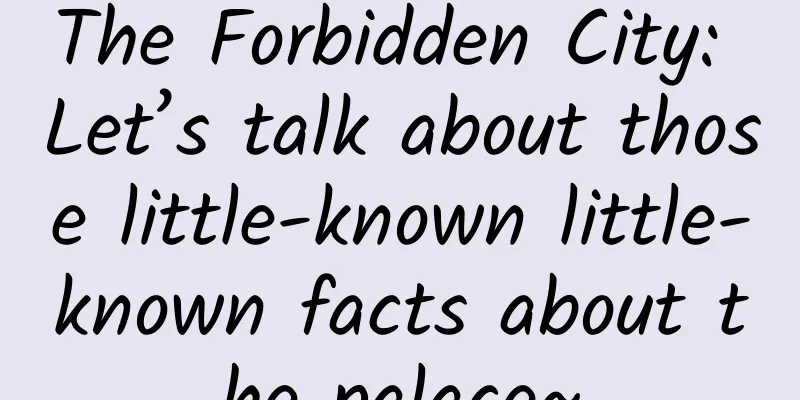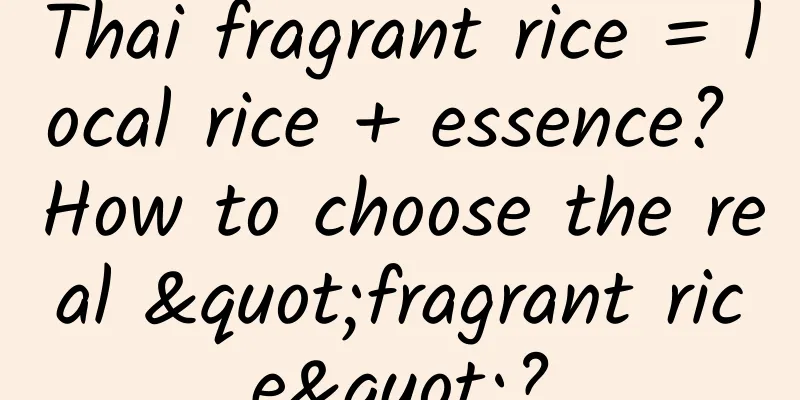The Forbidden City: Let’s talk about those little-known little-known facts about the palace~

|
The Forbidden City is a beautiful red It brings together the most exquisite aspects of traditional culture It embodies the beauty of Chinese civilization for thousands of years Witnessed China's 600-year history Enter the Forbidden City You walked into history Standing on the height of Jingshan Mountain and looking at the Forbidden City, you can see numerous palaces, layers of pavilions, and palace walls, which are intricately connected and well-organized. Such a magnificent complex and such a harmonious and unified layout are amazing. About the Forbidden City The Forbidden City, now called the Palace Museum (hereinafter referred to as the "Palace Museum"), was built in the fourth year of Emperor Yongle of the Ming Dynasty based on the Nanjing Palace Museum. Emperors of the Ming and Qing dynasties lived here. The name of the Forbidden City comes from the Purple Palace in the sky. The ancients observed the stars and found that the stars in the sky were all moving around the North Star, so they believed that it was the constellation where the Emperor of Heaven lived, and gave it an auspicious name according to traditional Chinese culture - Purple Star. Therefore, the place where the emperor lived was called the Forbidden City. Over the course of time, the Forbidden City has transformed from an imperial palace into a national treasure house. Carved beams and painted buildings, gold-plated paintings, rare treasures, and artisan craftsmanship... According to statistics, among the more than 1.8 million collections of the Palace Museum, nearly 1.56 million pieces are from the Qing Palace, accounting for about 86% of the total number of collections. As the largest and best-preserved palace complex in the world, the Forbidden City is a cultural treasure of all mankind and a precious cultural heritage of the Chinese nation. It has always been loved by everyone. -01- Why is there no hook on the word “门” (door) on the plaque in the Forbidden City? The last stroke of the Chinese character "门" on the plaque of the Forbidden City's tower has almost no hook. What's the reason? What kind of royal taboo is hidden behind it? In fact, the correct way to write the character "门" with a hook at the end was still in the Han Dynasty. It was not until the Southern Song Dynasty moved its capital to Lin'an that the Yudie Hall caught fire and the hall door was burned to ashes. A minister reported that the last stroke of the character "门" on the palace plaques had a hook at the end, and the "fire pen" would attract evil fire. Therefore, Song Gaozong Zhao Gou ordered all these plaques to be burned, and also stipulated that the "门" character on the palace plaques could not have a hook. In the early days of the Ming Dynasty, palaces, official residences, and city gates were gradually built. Once, Zhu Yuanzhang ordered the calligrapher Zhan Xiyuan to write a plaque for the Jixian Gate of the Imperial College. Zhan Xiyuan was a famous calligrapher in the early Ming Dynasty. When he wrote the plaque, he raised the last vertical line of the word "门" (gate) a little higher. After reading it, Emperor Taizu Zhu Yuanzhang was furious and said, "I originally wanted to summon wise men, but you want to close the door and block the way for wise men?" So he ordered Zhan Xiyuan to be beheaded, and used powder to cover the hook of the word "门" (gate). From then on, the Chinese character "门" (gate) in palaces, government offices, and city gates of the Ming Dynasty no longer had a hook. This was not only true for Nanjing City, but Zhu Di also followed this tradition when he built Beijing City. During the Qing Dynasty, Emperor Qianlong believed that the hooks on the doors could easily scratch his dragon scales, and he did not allow the word "door" on the inscriptions to have hooks. So an imperial decree was issued, and all the small hooks on the "door" on the plaques of the Forbidden City disappeared, and it became what we see in the Palace Museum today. -02- Are the door nails on the Forbidden City's doors just for appearance? One of the important features of the ancient buildings in the Forbidden City is that many of the gates are equipped with door nails arranged in orderly rows. Door nails were first recorded in the philosophical work "Mozi: Preparing for the City Gate" during the Warring States Period. Their main function was defense, and their shape was pointed and round. With the development of history, the decorative function of door nails has been enhanced, and their shape has also changed. For example, from the door nails unearthed from the Pingcheng Ruins of the Northern Wei Dynasty in Datong, Shanxi, to the door nails of the existing ancient buildings of the Ming and Qing Dynasties, their shapes are mostly round and bubble-shaped. The Forbidden City was the place where the emperors of the Ming and Qing Dynasties ruled and lived. The door nails of its ancient buildings combine practical and aesthetic functions, and reflect the rich ancient social culture. From the perspective of architectural technology, the door nails of the ancient buildings in the Forbidden City cleverly ensure the firmness and stability of the door panels. Door nails are used for solid doors, which is a type of gate of the ancient buildings in the Forbidden City. It is characterized by large size and strong defensiveness. The thickness of the door panel can reach 20 cm. It is often used in the four city gates of the Forbidden City and the palace gates of various palaces. The door panels of a solid door are sawn from logs, and the door panels are connected into a whole by threading. The specific method is to open holes on the sides of each door panel and then connect the door panels with threading. However, during the long-term opening and closing of the solid door, the connection between the threading and the door panel is easy to loosen, causing the threading to fall off from the holes in the door panel, causing the door panel to fall apart. The door nail is made of iron, which is small in size and high in strength. After being nailed into the connection between the door panel and the through-strap, it restricts the displacement of the door panel and the through-strap, which is conducive to the stability of the solid door. In addition, the nail cap (the part of the door nail protruding from the door panel) is made into a round bubble shape, which is convenient for the maintenance and replacement of the door nail. From this we can see that the door nails of the ancient buildings in the Forbidden City are a scientific application of ancient Chinese architectural technology. In addition, door nails also reflect the ancient Chinese ritual culture. The number of door nails in the ancient buildings of the Forbidden City is mostly nine rows and nine columns, and the number "9" is the largest yang number in ancient times, which means "heaven", that is, the supremacy of the imperial palace architecture. In ancient times, there were strict requirements for the use of door nails on the main gate. For example, the "Qing Dynasty Code" of the Qianlong Dynasty stipulated that the number of door nails on the main gates of the imperial palace should be nine rows and nine columns, and copper nails should be used; the number of door nails on the main gates of the imperial palace should be nine rows and seven columns; the number of door nails on the main gates of the prince's palace should be nine rows and seven columns; the number of door nails on the main gates of the prince's palace, ... In addition, the door nails of Donghua Gate of the Forbidden City are arranged in nine rows and eight columns, and the number "8" is an odd number. Some people believe that the coffins of ancient emperors would pass through Donghua Gate when leaving the palace, which has "yin energy", so the number of door nails is an odd number. In fact, this is not the case, because the Ming Tombs and the Eastern Qing Tombs are the mausoleums of the emperors of the Ming and Qing dynasties, and their door nails are also arranged in nine rows and nine columns. The reason why the number of door nails of Donghua Gate is an odd number is mainly related to the conflict between the five elements. The gates of the ancient buildings in the Forbidden City are decorated in red, and the door nails are decorated in golden yellow. Red and yellow are the main colors of the Forbidden City. Red means strong and fiery, while yellow was the exclusive color of royal palaces and temples in ancient times, implying elegance and luxury. -03- Is the Forbidden City made up entirely of Chinese-style buildings? It is not entirely composed of Chinese-style buildings, among which the more typical building is Yude Hall. Yude Hall is a group of buildings in the northwest corner of the Wuying Hall complex inside the Xihua Gate of the Forbidden City. The main body is located on the west side of the Wuying Hall. This group of buildings consists of the main hall with yellow glazed tiles, the porch, etc. Compared with many buildings in the Forbidden City, it has few unique features. What makes it different is the Islamic-style building with a dome roof and white ceramic tiles on the inner walls, which is called the Yude Hall Bathroom. Since the Wuying Hall was opened to the public as an exhibition hall for antiques, the construction time and original purpose of the Yudetang Bathhouse have become a hot topic of discussion in society and academia. -04- The Forbidden City “encountered” a crow, which was not only adorable but also a “divine bird”? If we talk about the animals with the strongest "presence" in the Forbidden City, the crow must be one of them. The ancients regarded crows and magpies as the same kind, and whether it is crows, jackdaws or magpies, they are all endowed with rich cultural connotations. Perhaps in our eyes today, crows are not a lovable creature. However, from the mythological images such as the Golden Crow, we can see that crows were once regarded as a sign of good fortune in ancient times; in the legends of the Qing Dynasty, crows and magpies were also "divine birds" that saved their ancestors. The illustrations of the "Manchu Veritable Records" repainted during the Qianlong period depicted scenes such as "the divine magpie saves Fan Cha" and "a flock of crows blocks the road to Wulikan". "The crow knows how to repay its parents, so it is called the kind crow." The jackdaw was praised as a filial bird by the ancients because of the story of it repaying its parents' parents. In many paintings and calligraphy works, jackdaws are combined with images such as dead trees and broken stones to create a desolate and bleak atmosphere. In the paintings of Tang Yin and Zhu Da, jackdaws are either perched on dead branches or stand alone and unruly, with vivid and lifelike images. Source: Chongqing Jiulongpo District Cultural Relics Management Office Audit expert: Li Xiaoying Statement: Except for original content and special notes, some pictures are from the Internet. They are not for commercial purposes and are only used as popular science materials. The copyright belongs to the original authors. If there is any infringement, please contact us to delete them. |
>>: You think the sea is blue? Actually, your eyes deceive you.
Recommend
To master fission and increase followers, just grasp these 3 points!
Since the fission processes are similar, you can ...
Douyin brand went from a rookie to a super Douyin anchor in 3 days, a plan to cultivate tens of millions of Douyin anchors
Douyin Brands: From a rookie to a super Douyin an...
The premature birth and premature death of China Mobile's "5G message"
On May 11, the 5G Message App launched by China M...
Look once, it's weird, look again
There is a type of insect that lives on the earth...
Huang Hongsheng, who denounced Xu Jiayin, awakened his "car-making bloodline" in prison and now sells 3,600 cars a month
"Xu Jiayin left debts to society, his wife a...
Didi "Hua Xiaozhu" taxi product analysis report
Hua Xiaozhu is an app owned by Didi , known as th...
How much does it cost to customize the Wuhan photography mini program? What is the price quote for customizing the Wuhan photography app?
There is no doubt that the topic of mini programs...
Precise positioning of Moments ads, do you want to know how WeChat sees you?
Do you want to know how WeChat sees you? Since th...
Vivo's "long-termism" is out of control: market share declines, high-end products are hard to find
Although it no longer appears frequently in peopl...
When will the Shanghai epidemic end in 2022 and return to normal? What is the specific list of closed communities? Attached the latest news
Recently, there are still many confirmed cases in...
How much does it cost to make the Yongxin Food Mini Program? What is the quotation for the production of Yongxin Food Mini Program?
The mini program provides convenience for publici...
Cloudrive 3.0, an integrated dual-map navigation system, is first installed on Tiggo 5x, opening up a new way of intelligent human-vehicle life
What will the future of car life look like? With ...
The most complete! Summary of Zhihu’s traffic marketing strategies!
Did you know: What kind of brands are suitable fo...
As long as there is light, you can surf the Internet! What is Li-Fi, which is said to be better than Wi-Fi?
Even if you have never heard of Li-Fi, you now kno...
ChatGPT is a big hit! Is it really that amazing? Who do you think wrote this article?
Recently, two artificial intelligence systems hav...









